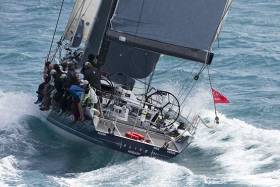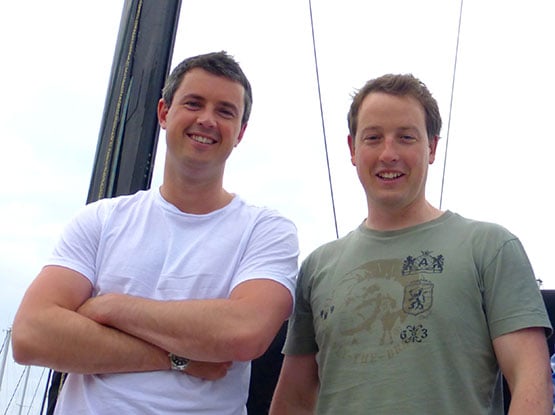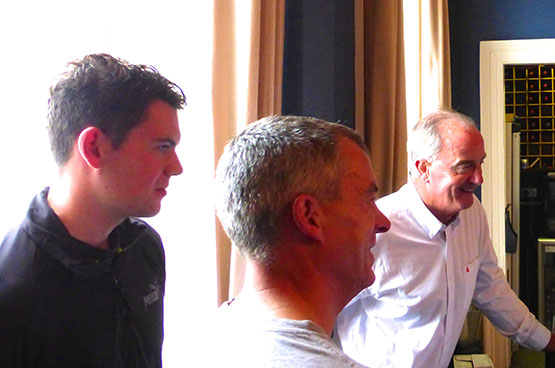Displaying items by tag: Offshore Racing Congress
The Empire Strikes Back: RORC Active on Two Fronts in Two Oceans
Sailing forums have seen exchanges in recent days about the relative global coverage of the Royal Ocean Racing Club’s (RORC) measurement system - the International Rating Certificate (IRC) - and the Offshore Racing Congress’s (ORC) Offshore Rating Certificate.
Dobbs Davis (US), the Chairman of the ORC’s Promotions & Development Committee, and Zoran Grubisa (Croatia), who heads the organisation’s Rating Officer Committee, were in Limerick three weeks ago at the Irish Cruiser Racer Association (ICRA) Annual Conference to make a presentation about their measurement organisation, its methods systems, and its level of world coverage.
This made available yet another fascinating nugget of top-level information for a wide-ranging conference which reflected the considerable influence the ICRA model has in international racing for boats with lids. And at the same time it ensured a good turnout to applaud the ICRA Boat of the Year title going to George Sisk’s WOW from Dun Laoghaire, and to witness the transfer of the role of ICRA Commodore from Nobby Reilly of Howth to Simon McGibney of Foynes. It’s the first time that ICRA has had a Commodore from the western seaboard since its foundation by Fintan Cairns of Dun Laoghaire and the late Jim Donegan of Cork in 2002.
Afloat.ie’s W M Nixon was in Limerick to take the pulse of this unique body, and his commentary in Sailing on Saturday of 12th March ruffled more than a few feathers, and greatly heightened interest in the RORC’s global programme, which has its European section swinging into action this weekend with the Easter Challenge on the Solent.
Who knows, but some time in the future it may be that Rory Staunton of Mayo Sailing Club will be remembered as the man who finally got the IRC and the ORC to get together by crisply pointing out - at the end of Dobbs Davis’s presentation to the ICRA conference - that as far as ordinary sailors were concerned, when IRC and ORC were both used in one event, the results often seemed very comparable. And while it was no harm some times to have two sets of winners (and even more if you include ICRA’s own Progressive ECHO system), at the top international level it only makes sense to Joe Public to have one undisputed winner in each class.
For the world promotion of offshore racing, the optics would surely be much better if everyone was racing to the same rating system? But it will take a while yet to reach this happy situation, for at the moment the ORC and the IRC appear to be in active competition, and regular visitors to the Afloat.ie website will be well aware that some very powerful voices have weighed in on the RORC/IRC side recently, going so far as to question the accuracy of the fleet numbers made in some ORC claims, and pointing to the IRC’s current areas of rapid expansion in southeast Asia and other regions.

Neil Pryde’s characterful Welbourn 52 Hi Fi won the Rolex RORC China Sea Race in 2012 and 2014
But actions speak louder than words, and this week sees the RORC hyper-busy in the Pacific with the biennial Rolex China Sea Race of 595 miles from Hong Kong to Manila in the Philippines, while on the eastern fringes of the Atlantic in the Solent at Cowes, there’s the annual Easter Challenge, an event with an approved integral training emphasis, as top coach Jim Saltonstall and his team will be buzzing through the fleet in their RIBs giving advice to those who have sought it.
With the Easter weekend’s all-too-evident weather deterioration in progress, it’s likely that yesterday will have given the fleet of fifty or so their pleasantest sailing conditions. But with the RORC secretariat decamped for the long weekend from world headquarters in St James’s in London to the club’s waterfront base in the Royal Corinthian YC in Cowes, a sense of being able to go home at the end of a hard day’s racing will ease the harshness of the conditions.
On the other hand, the fact that the RORC now has a bricks-and-mortar Cowes base in what was once the legendary Rosa Lewis’s “seaside cottage” will provide ammunition for those who would claim that the RORC, and the IRC with it, have essentially become a Solent-centric setup. Thus the fact that the Rolex China Sea Race under the RORC imprimatur is taking place at the same time is very helpful indeed for those who would promote IRC as the world’s measurement system.
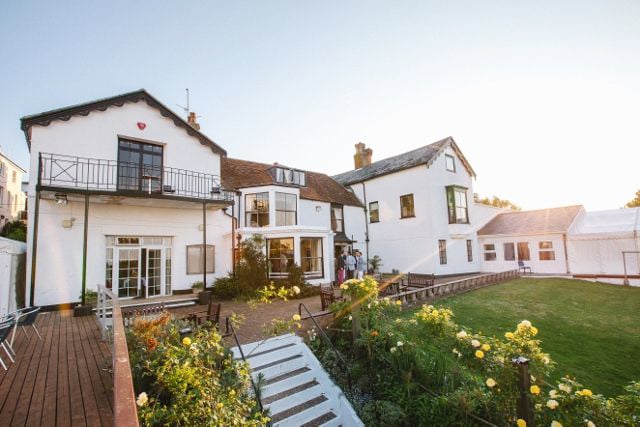
The nice little place by the seaside…..The Royal Corinthian YC in Cowes – a byword for hospitality – is now the RORC’s Solent base
In times past, leading Irish skippers with a Hong Kong base such as Paul Winkelmann and Jamie McWilliam have featured in the China Sea Race, for it has a history as a biennial event going back to 1962, when three yachts – one each from Hong Kong, the Philippines and Japan – raced this decidedly disputed bit of water. The situation was such that a naval vessel from Hong Kong accompanied them for the first two hundred miles, and then a hundred miles out from Manila, they were met by a ship from the Philipinnes navy.
The line honours and handicap winner was Chris von Sydow’s yawl Reverie, one of those classic American-style yawls of the Finisterre type which were being widely built in the region at the time, mostly for export. They were guaranteed as teak through and through, for as one sardonic observer put it, the wonderwood was so abundant out there in those days that if the team in the boatyard felt like a brew-up of tea, they’d boil their kettle on a little fire made with teak kindling.
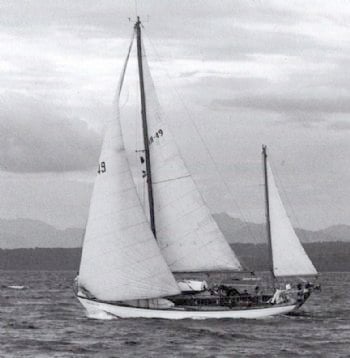
The winner of the first China Sea Race in 1962 was Chris von Sydow’s yawl Reverie

A trophy to match. Only a race right across the China Sea would merit a prize like this
Reverie’s time was four days 11 hours and 29 minutes, and she got the very distinctive China Sea Trophy, which is of such a style it just couldn’t be the prize for any other major offshore race. Gradually the numbers built up as it became an established biennial event, in 1972 the RORC came aboard as partners, and it hasn’t looked back since. There’s been some spectacular sailings, the record being set in 2000 by Karl Kwok’s Open 60 Beau Geste, which cracked the two day barrier by coming in on 47 hours and 43 minutes, just 17 minutes maybe, but it was 17 minutes the right way.
The races of 2012 and 2014 were won by Neil Pryde’s rather special Hugh Welbourn-designed 52 footer Hi Fi, but she’s not in this year’s fleet which got under way on Wednesday and has the front runners well in already, though only after a start in miserable conditions which improved in terms of sailing power to have a 28-knot nor’easter building in a monsoon. This made the going good the further you were down the course, but yesterday the little fellows at the tail end were taking a bit of a pasting.
Line honours were taken yesterday (Friday) evening by Australian Philip Turner’s Reichel Pugh 66 Alive, which covered 244 nm in the final 24 hours to set a new course record, though just 11 minutes inside Beau Geste’s remarkable 2000 time – who’d have thought it would stand for sixteen years? Overall on handicap, Alive currently also has it every which way, but things are also looking good for the Ker 42 Black Baza (Anthony Root).
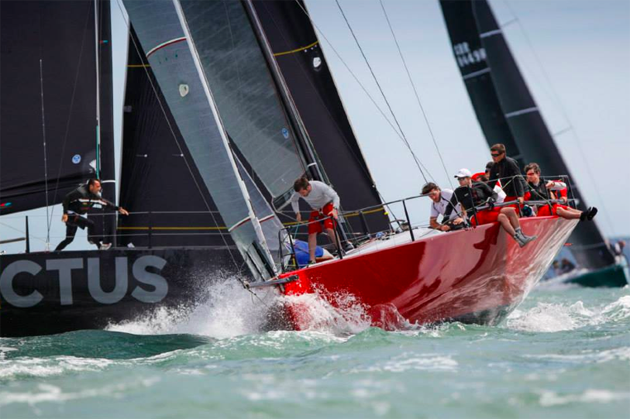
Cutting it close. Anthony O’Leary’s Antix in a neat-enough port-and-starboard situation with the even newer Ker 40 Invictus
Conditions in Manila may not be idyllic, but at least they’re a bit warmer than the Solent this morning with a succession of fronts set to sweep through for much of he remainder of the Easter Holiday. Irish interest is high as Anthony O’Leary’s Munster-red Ker 40 Antix is defending champion, and the skipper was in fine form in Thursday as he outlined prospects and talked us through some of the usual suspects who will be sailing on this very attractive boat.
Following his accident while racing Antix in ferocious conditions last July, it’s great news that Dylan Gannon of Howth is back on the strength, along with his shipmate Ross MacDonald who had a truly prodigious season in 2015, playing a leading role in crewing Antix while at the same time campaigning his family’s veteran X332 Equinox to such good effect that he was top boat at the ICRA Nats in Kinsale.
Back on the strength. Dylan Gannon (left) and Ross MacDonald are both sailing on Antix his weekend. Photo: W M Nixon
Two new additions to the Antix strength are Will Byrne from Howth, who was recently making the scene with Half Ton Classics World Champion Dave Cullen and the gang in the C & C 30 championship in Florida in January, and young Cian Guilfoyle from the National Yacht Club in Dun Laoghaire, who leapt to fame as the third man aboard the J/80 when Anthony O’Leary retained the Helmsman’s Championship of Ireland by a considerable margin at the NYC in October, with longtime shipmate Dan O’Grady the man in the middle.

Cian Guilfoyle maximising his righting moment while crewing for Anthony O’Leary in the victory in the Helmsmans Championship, October 2015. Photo: David O’Brien
Winning team. Cian Guilfoyle, Dan O’Grady and Anthony O’Leary in the NYC after winning the Helmsmans Championshjp 2015. This weekend, Guilfoyle has joined the crew of Antix. Photo: W M Nixon
The other top Irish contender in the RORC Easter Challenge is also from Cork, Conor Phelan’s Ker 36 (or is she a 37) Jump Juice of 2008 vintage. This makes her something of a veteran but she’s by no means the oldest boat competing, as one doughty skipper has turned up with a Mumm 36, which is like a bit of living history. Yet she’s in with as much of a shout as anyone else if the IRC is doing its work properly, which seems to be where we came in…….
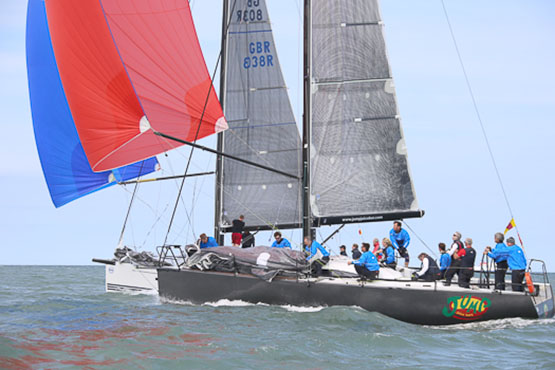
Back in the day…….the new Ker 36 Jump Juice makes her debut in 2008
But we cannot depart without musing on the makeup of this year’s Brewin Dolphin Commodore’s Cup team which will be defending for Ireland. As other people get agitated about the lack of heads above the parapet to indicate the beginnings of a buildup, Anthony O’Leary is reassuringly philosophical about the whole business.
He is of course very much up for it with Antix, and he’s well aware that there’s another good possibility with RORC Commodore Michael Boyd (Royal Irish YC) in line to be campaigning the works JPK 1080 as the season gets going, and of course the JPK 1080 is the boat du jour. As for a third boat, if Jump Juice is reluctant to make the commitment, they’ll be on the lookout for a boat rating 1.049 or above.
But it’s early days yet. As O’Leary recalls with quiet amusement, in assembling the 2014 team from scratch and the non-defence of 2012, he refused to let himself think that the new Ker 40 Catapult was a certainty until he actually saw her unloaded from a ship from America onto a quayside in Europe.
Yet she arrived on time. But it was the Steady Eddy of the team, the Grand Soleile 43 Quokka 8, which ended up causing the most concern. Her charter had been firmly in place since November 2013, but then there came a complete foul-up with delivery schedules back from campaigning in the Caribbean. It was more than a rush to have Quokka race ready for the preliminary jousting in Volvo Cork Week in July 2014. But not to worry. She ended up as champion in Cork Week, and made a solid contribution to the Commodore’s Cup win in which Catapult (which has since become Antix) was top-scoring individual boat.



























